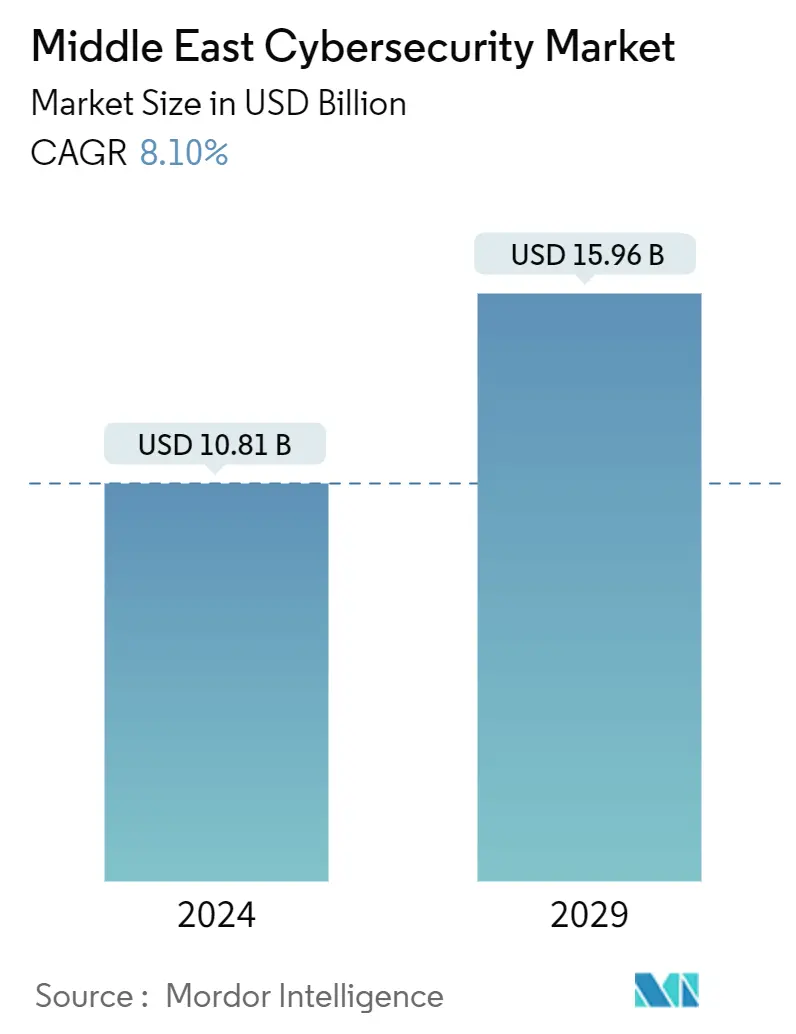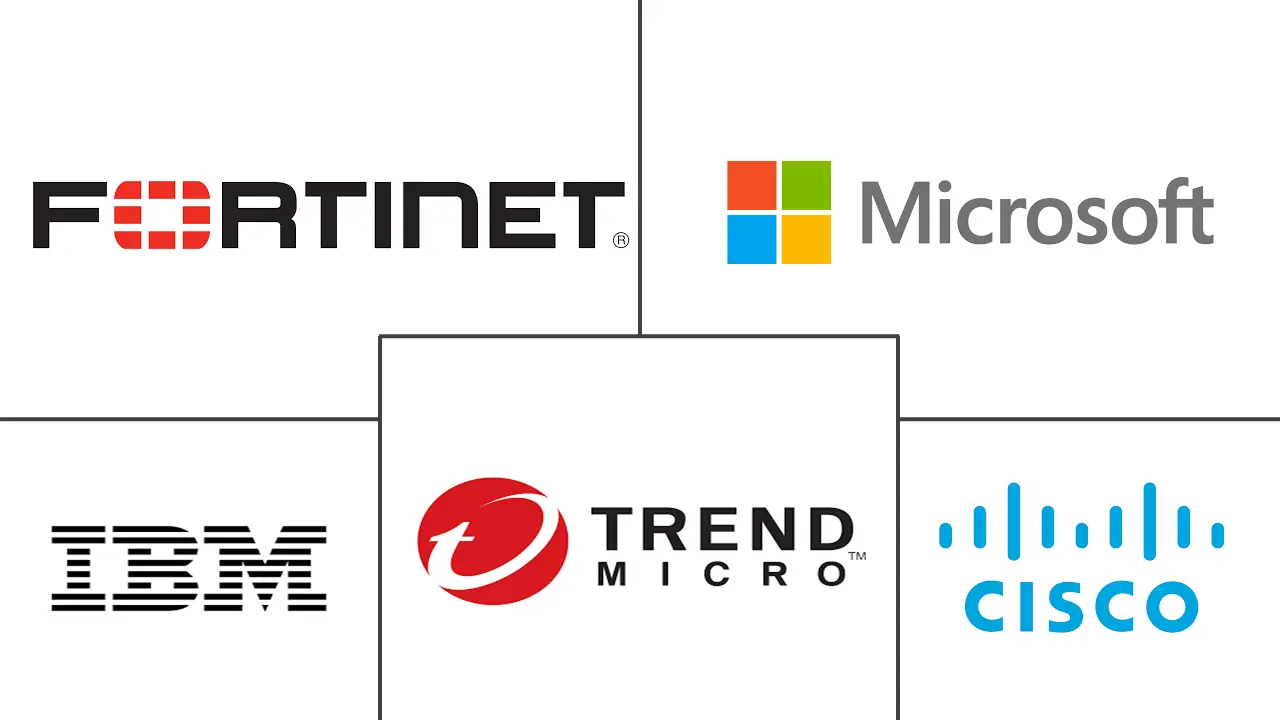Market Size of Middle East Cybersecurity Industry

| Study Period | 2019-2029 |
| Base Year For Estimation | 2023 |
| Forecast Data Period | 2024 - 2029 |
| Market Size (2024) | USD 10.81 Billion |
| Market Size (2029) | USD 15.96 Billion |
| CAGR (2024 - 2029) | 8.10 % |
| Market Concentration | Low |
Major Players
*Disclaimer: Major Players sorted in no particular order |
Middle East Cybersecurity Market Analysis
The Middle East Cybersecurity Market size is estimated at USD 10.81 billion in 2024, and is expected to reach USD 15.96 billion by 2029, growing at a CAGR of 8.10% during the forecast period (2024-2029).
The key drivers contributing to the increase in the adoption of data-intensive approaches and decisions with the growth include the increase in the number of cyberattacks in the Middle East with the growing digitalization.
- The pandemic boosted digital transformation in the Middle East and increased the demand for cybersecurity solutions to protect remote work environments. Businesses prioritize robust cyber defenses, fueling growth in the cybersecurity market across the region.
- Earlier, the Middle East did not witness a significant target for cyberattacks. Regions such as Europe and North America have always been majorly affected by cyber threats. However, rapid digitalization in countries such as Saudi Arabia and the UAE has recently boosted the number of connected devices, opening new gateways for cyberattacks.
- Governments in the region are also growing their investments in information and communication technology. As a result, the region's social infrastructure, financial sector, government services, schools, and hospitals have been deploying interconnectivity solutions with less attention to these developments' security requirements.
- However, the significant factors driving the threat of cyberattacks in the Middle East are increasing vulnerabilities in digital communications networks and supply chains, rapid development in the user base of online consumers, and, chiefly, the deficient cybersecurity infrastructure.
- Traditional authentication methods, such as passwords, PINs, and security tokens, have been the cornerstone of digital security for many years. Users must remember and provide unique credentials to access their accounts or sensitive data. While these methods are popular, they also have drawbacks, such as weak passwords, reused passwords, and vulnerability to phishing attacks. The high reliance on these traditional authentication methods is posing a challenge to the market's growth.
- As the economy moves toward digital transformation aligned with Saudi Vision 2030, more businesses are adopting cloud solutions and other online application platforms. In addition, the number of accessible components remotely is also rising across industries, providing additional points of vulnerability. These factors contribute to the increased cyber-attack rate, driving the demand for effective cybersecurity measures in the post-COVID-19 Scenario.
Middle East Cybersecurity Market Industry Segmentation
Cyber security covers all aspects of the protection of an organization and its staff and assets against cyber threats. A wide range of cyber security solutions is needed in order to reduce corporate cyber risks, given the increasing frequency and sophistication of attacks, as well as more complex corporate networks.
The cybersecurity market in the Middle East is segmented by offering (solution [application security, cloud security, data security, identity & access management, network security equipment, infrastructure protection, integrated risk management, consumer security software, application security, and other solutions], services [professional services, managed services]), deployment mode (cloud, on-premise), organization size (SMEs, large enterprises), end-user industry (IT & telecom, BFSI, retail & E-Commerce, government, manufacturing, healthcare, and other end-user industries), country (Saudi Arabia, United Arab Emirates, Qatar, Kuwait, Bahrain, Rest of Middle East). The market sizes and forecasts are provided in terms of value (USD) for all the above segments.
| By Offering | |||||||||||
| |||||||||||
|
| By Deployment Mode | |
| Cloud | |
| On-premises |
| By Organization Size | |
| SMEs | |
| Large Enterprises |
| By End-user Industry | |
| IT & Telecom | |
| BFSI | |
| Retail & E-commerce | |
| Government | |
| Manufacturing | |
| Healthcare | |
| Other End-user Industries |
| By Country | |
| Saudi Arabia | |
| United Arab Emirates | |
| Qatar | |
| Kuwait | |
| Bahrain | |
| Rest of Middle East (Including Iraq, Jordan, Lebanon, etc.) |
Middle East Cybersecurity Market Size Summary
The Middle East cybersecurity market is experiencing significant growth, driven by the increasing frequency of cyberattacks and the rapid digital transformation across the region. As countries like Saudi Arabia and the UAE embrace digitalization, the number of connected devices has surged, creating new vulnerabilities that cybercriminals are eager to exploit. The COVID-19 pandemic further accelerated this trend, as businesses sought to secure remote work environments, thereby boosting the demand for robust cybersecurity solutions. Governments are also investing heavily in information and communication technology, which, while enhancing connectivity in sectors such as finance, healthcare, and education, has also highlighted the need for stronger security measures. Traditional authentication methods are proving inadequate, prompting a shift towards more advanced cybersecurity solutions to protect sensitive data and critical infrastructure.
The adoption of cloud-based cybersecurity solutions is on the rise, fueled by their scalability, flexibility, and cost-effectiveness. As organizations increasingly rely on cloud services, the need for secure cloud-based solutions becomes paramount, especially with the growing number of 5G subscribers in the region. This technological advancement offers enhanced connectivity but also presents new cybersecurity challenges. The UAE, in particular, is witnessing a surge in demand for cybersecurity solutions, driven by its push towards a digital economy and government initiatives aimed at bolstering cybersecurity capabilities. Partnerships between global tech giants and local companies are expanding, further strengthening the cybersecurity landscape. The market is characterized by a mix of established players and new entrants, all vying to address the region's evolving cybersecurity needs.
Middle East Cybersecurity Market Size - Table of Contents
-
1. MARKET INSIGHTS
-
1.1 Market Overview
-
1.2 Analysis of Macroeconomic Scenarios
-
1.3 An Assessment of the Impact of and Recovery From COVID-19
-
-
2. MARKET SEGMENTATION
-
2.1 By Offering
-
2.1.1 Solution
-
2.1.1.1 Cloud Security
-
2.1.1.2 Data Security
-
2.1.1.3 Identity Access Management (IAM)
-
2.1.1.4 Network Security Equipment
-
2.1.1.5 Infrastructure Protection
-
2.1.1.6 Integrated Risk Management
-
2.1.1.7 Consumer Security Software
-
2.1.1.8 Application Security
-
2.1.1.9 Other Solutions
-
-
2.1.2 Services
-
2.1.2.1 Professional Services
-
2.1.2.2 Managed Services
-
-
-
2.2 By Deployment Mode
-
2.2.1 Cloud
-
2.2.2 On-premises
-
-
2.3 By Organization Size
-
2.3.1 SMEs
-
2.3.2 Large Enterprises
-
-
2.4 By End-user Industry
-
2.4.1 IT & Telecom
-
2.4.2 BFSI
-
2.4.3 Retail & E-commerce
-
2.4.4 Government
-
2.4.5 Manufacturing
-
2.4.6 Healthcare
-
2.4.7 Other End-user Industries
-
-
2.5 By Country
-
2.5.1 Saudi Arabia
-
2.5.2 United Arab Emirates
-
2.5.3 Qatar
-
2.5.4 Kuwait
-
2.5.5 Bahrain
-
2.5.6 Rest of Middle East (Including Iraq, Jordan, Lebanon, etc.)
-
-
Middle East Cybersecurity Market Size FAQs
How big is the Middle East Cybersecurity Market?
The Middle East Cybersecurity Market size is expected to reach USD 10.81 billion in 2024 and grow at a CAGR of 8.10% to reach USD 15.96 billion by 2029.
What is the current Middle East Cybersecurity Market size?
In 2024, the Middle East Cybersecurity Market size is expected to reach USD 10.81 billion.

